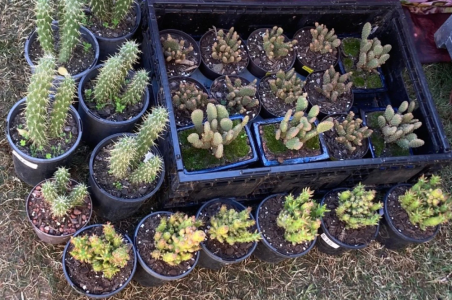Are you missing this dangerous biosecurity threat hiding in plain sight?
By
Gian T
- Replies 0
When we think of biosecurity threats, most of us picture exotic bugs, snakes, or even the odd cane toad hopping about. But would you ever suspect that a humble pot plant on your windowsill could be a ticking time bomb for our environment?
That’s exactly the warning being sounded by the Sunshine Coast Council after a photo of 25 young cacti—innocent-looking enough to the untrained eye—sparked a serious biosecurity alert. These spiky little invaders, which were being sold at a local event, are far from harmless. In fact, they’re considered 'destructive invaders' and are strictly illegal to grow, keep, or sell in Queensland and many other parts of Australia.
**The Hidden Dangers Lurking in Your Garden**
The cacti in question include the Blind cactus (Opuntia rufida), Bunny ears cactus (Opuntia microdasys), and Coral cactus (Cylindropuntia fulgida). While they might look quirky and cute, these species are anything but friendly to our native landscapes. According to Biosecurity Queensland, these cacti are classified as invasive species and hefty fines can apply if you’re caught with them in your possession—whether you bought them at a market, online, or even inherited them from a friend.
It’s not just about breaking the rules, either. These plants can cause real, lasting damage. As Councillor Maria Suarez explained, 'Many invasive plants were previously sold as garden plants and could be hiding on private properties. Others spread by birds or the wind, finding their way into gardens. From there, they can spread to our creeks, reserves, dunes and other natural areas.'
**Why Are Invasive Cacti Such a Problem?**
You might be wondering: what’s the big deal about a few cacti? The answer is that these plants are incredibly tough and can outcompete our native species. They form dense thickets that smother native vegetation, making it hard for anything else to grow. For farmers and graziers, the problem is even worse—these cacti can take over pastures, reduce grazing land, and their sharp spines can injure livestock.
Take the Harris cactus, for example. Originally introduced as an ornamental plant in the 1800s, it’s now a major pest in Queensland. It thrives in poor soil, spreads easily through seeds and broken segments, and is almost impossible to get rid of once it takes hold. Its fruit, which is eaten by birds and other animals, helps it spread even further.
**The Cost to Our Environment and Economy**
The impact of invasive cacti isn’t just environmental—it’s economic, too. Removing these plants from infested areas is incredibly difficult and expensive. Once they’ve established themselves, they can take years (and a lot of money) to control. And it’s not just cacti: other invasive plants like annual ragweed can cause health problems for people, while others threaten our unique biodiversity.
**What Can You Do to Help?**
The good news is that everyone can play a part in protecting our natural spaces. Councillor Tim Burns urges residents to keep an eye out for suspicious plants and report them to the council. 'If you’re the person in the know on invasive plants, you can spot a priority weed before it escapes and manage it effectively, or report weeds on Council’s eradication and prevention lists,' he said.
If you’re not sure whether a plant in your garden is a problem, check your local council’s biosecurity plan or reach out to a native nursery for advice. And if you spot any of the banned cacti or other invasive species for sale—whether online or at a market—report it straight away.
**How to Safely Remove Invasive Plants**
If you discover a prohibited plant on your property, don’t panic! The first step is to identify it correctly—your local council or a native nursery can help. Once confirmed, follow approved removal methods (never just dump them in the green waste bin, as this can help them spread). Some councils offer free collection or disposal services for invasive plants.
**Aussies Urged to Stay Vigilant**
With new invasive species being added to the 'hit list' every year—including drooping tree pear cactus, cane cactus, Eve’s pin cactus, and various cholla cacti—it’s more important than ever to stay vigilant. These plants might look harmless, but they pose a serious risk to our environment, agriculture, and even our health.
**Support Local, Buy Native**
If you’re looking to add some greenery to your garden, why not choose native plants instead? Not only are they beautiful and well-suited to our climate, but they also support local wildlife and help keep our ecosystems healthy.
**Have Your Say!**
Have you ever spotted a suspicious plant in your neighbourhood? Or maybe you’ve accidentally bought an invasive species without realising? Share your stories and tips in the comments below—let’s help each other keep our gardens (and our country) safe!
And remember, if in doubt, check with your local council or native nursery before buying or planting anything new. Together, we can stop these hidden threats before they take root.
---
**For more information on invasive species and how to report them, visit your local council’s website or Biosecurity Queensland.**
Stay safe, stay green, and happy gardening!

That’s exactly the warning being sounded by the Sunshine Coast Council after a photo of 25 young cacti—innocent-looking enough to the untrained eye—sparked a serious biosecurity alert. These spiky little invaders, which were being sold at a local event, are far from harmless. In fact, they’re considered 'destructive invaders' and are strictly illegal to grow, keep, or sell in Queensland and many other parts of Australia.
**The Hidden Dangers Lurking in Your Garden**
The cacti in question include the Blind cactus (Opuntia rufida), Bunny ears cactus (Opuntia microdasys), and Coral cactus (Cylindropuntia fulgida). While they might look quirky and cute, these species are anything but friendly to our native landscapes. According to Biosecurity Queensland, these cacti are classified as invasive species and hefty fines can apply if you’re caught with them in your possession—whether you bought them at a market, online, or even inherited them from a friend.
It’s not just about breaking the rules, either. These plants can cause real, lasting damage. As Councillor Maria Suarez explained, 'Many invasive plants were previously sold as garden plants and could be hiding on private properties. Others spread by birds or the wind, finding their way into gardens. From there, they can spread to our creeks, reserves, dunes and other natural areas.'
**Why Are Invasive Cacti Such a Problem?**
You might be wondering: what’s the big deal about a few cacti? The answer is that these plants are incredibly tough and can outcompete our native species. They form dense thickets that smother native vegetation, making it hard for anything else to grow. For farmers and graziers, the problem is even worse—these cacti can take over pastures, reduce grazing land, and their sharp spines can injure livestock.
Take the Harris cactus, for example. Originally introduced as an ornamental plant in the 1800s, it’s now a major pest in Queensland. It thrives in poor soil, spreads easily through seeds and broken segments, and is almost impossible to get rid of once it takes hold. Its fruit, which is eaten by birds and other animals, helps it spread even further.
**The Cost to Our Environment and Economy**
The impact of invasive cacti isn’t just environmental—it’s economic, too. Removing these plants from infested areas is incredibly difficult and expensive. Once they’ve established themselves, they can take years (and a lot of money) to control. And it’s not just cacti: other invasive plants like annual ragweed can cause health problems for people, while others threaten our unique biodiversity.
**What Can You Do to Help?**
The good news is that everyone can play a part in protecting our natural spaces. Councillor Tim Burns urges residents to keep an eye out for suspicious plants and report them to the council. 'If you’re the person in the know on invasive plants, you can spot a priority weed before it escapes and manage it effectively, or report weeds on Council’s eradication and prevention lists,' he said.
If you’re not sure whether a plant in your garden is a problem, check your local council’s biosecurity plan or reach out to a native nursery for advice. And if you spot any of the banned cacti or other invasive species for sale—whether online or at a market—report it straight away.
**How to Safely Remove Invasive Plants**
If you discover a prohibited plant on your property, don’t panic! The first step is to identify it correctly—your local council or a native nursery can help. Once confirmed, follow approved removal methods (never just dump them in the green waste bin, as this can help them spread). Some councils offer free collection or disposal services for invasive plants.
**Aussies Urged to Stay Vigilant**
With new invasive species being added to the 'hit list' every year—including drooping tree pear cactus, cane cactus, Eve’s pin cactus, and various cholla cacti—it’s more important than ever to stay vigilant. These plants might look harmless, but they pose a serious risk to our environment, agriculture, and even our health.
**Support Local, Buy Native**
If you’re looking to add some greenery to your garden, why not choose native plants instead? Not only are they beautiful and well-suited to our climate, but they also support local wildlife and help keep our ecosystems healthy.
**Have Your Say!**
Have you ever spotted a suspicious plant in your neighbourhood? Or maybe you’ve accidentally bought an invasive species without realising? Share your stories and tips in the comments below—let’s help each other keep our gardens (and our country) safe!
And remember, if in doubt, check with your local council or native nursery before buying or planting anything new. Together, we can stop these hidden threats before they take root.
---
**For more information on invasive species and how to report them, visit your local council’s website or Biosecurity Queensland.**
Stay safe, stay green, and happy gardening!
Key Takeaways
- Sunshine Coast Council has issued a warning about the sale of invasive cacti species, which are illegal to grow, keep, or sell in Queensland due to the damage they cause to the environment and agriculture.
- Species such as the Blind cactus, Bunny ears cactus, Coral cactus, drooping tree pear cactus, cane cactus, Eve’s pin cactus, and prohibited cholla cacti are all on the council’s eradication list and must be destroyed following approved methods.
- Invasive cacti can spread rapidly, smothering native vegetation, reducing grazing land, injuring livestock, and posing risks to human health, with eradication being difficult and costly once established.
- Residents are encouraged to survey their properties for these plants, remove them if found, report any sightings of priority weeds, and buy plants from local native nurseries to help protect Australia’s unique biodiversity.








